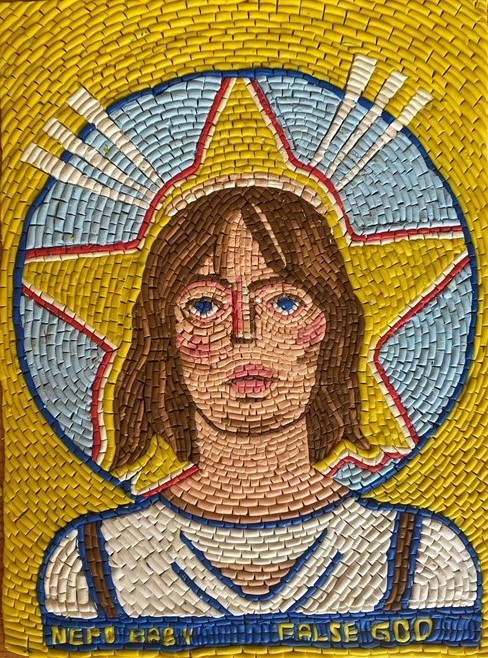"Nepo Baby False God”: Reimagining Early Medieval Roman Apse Mosaics in a Contemporary Context
Item
Title
"Nepo Baby False God”: Reimagining Early Medieval Roman Apse Mosaics in a Contemporary Context
Description
For this project, I used coloured modelling clay to recreate an early medieval Roman apse mosaic and translate it into a contemporary art piece that comments on the social status of Hollywood’s newest celebrities, the children of the prevailing celebrity class, or “Nepo babies.”
My piece is a portrait of Maya Hawke, the up-and-coming Stranger Things actress and daughter of Ethan Hawke and Uma Thurman. In the piece, Hawke is surrounded by a star-like halo of gold, exuding beams of light and creating a light blue divine orb around her face. Unlike her usual award show attire, her clothing is a humble white robe, and the bottom of the piece is framed with the gold text: “NEPO BABY FALSE GOD” on a dark blue border.
The inspiration for this piece comes from the portraiture of a ninth-century triumphal arch and apse mosaic in Saint Zeno’s Chapel in Santa Prassede, Rome, which illustrates the Second Coming of Christ amongst Saints and worshippers. By reimagining features of the original mosaic, like the golden inscription at the bottom, the colour palette, the style of portraiture, the clothing, and the cross-like halo behind Christ’s head, I used conventional medieval elements (and scholarly analyses of their meanings) to replicate the style while also criticizing the almost divine significance of Nepo babies in popular culture.
The project was a wonderful opportunity to use my hands and engage in more creative activities this exam season, and I am really proud of my final product!
My piece is a portrait of Maya Hawke, the up-and-coming Stranger Things actress and daughter of Ethan Hawke and Uma Thurman. In the piece, Hawke is surrounded by a star-like halo of gold, exuding beams of light and creating a light blue divine orb around her face. Unlike her usual award show attire, her clothing is a humble white robe, and the bottom of the piece is framed with the gold text: “NEPO BABY FALSE GOD” on a dark blue border.
The inspiration for this piece comes from the portraiture of a ninth-century triumphal arch and apse mosaic in Saint Zeno’s Chapel in Santa Prassede, Rome, which illustrates the Second Coming of Christ amongst Saints and worshippers. By reimagining features of the original mosaic, like the golden inscription at the bottom, the colour palette, the style of portraiture, the clothing, and the cross-like halo behind Christ’s head, I used conventional medieval elements (and scholarly analyses of their meanings) to replicate the style while also criticizing the almost divine significance of Nepo babies in popular culture.
The project was a wonderful opportunity to use my hands and engage in more creative activities this exam season, and I am really proud of my final product!
Contributor
Rana Guler

